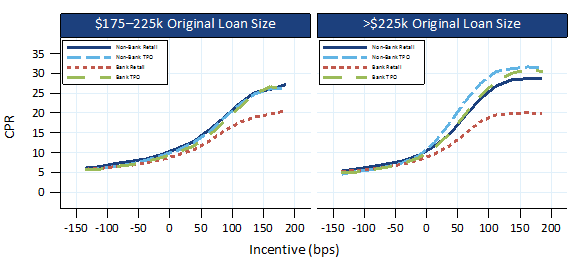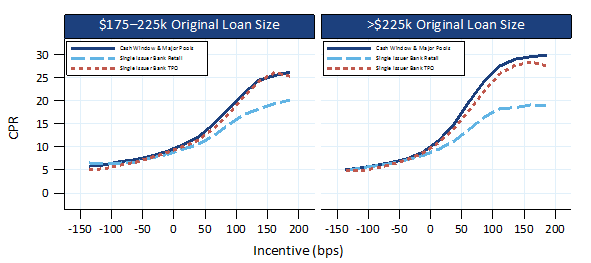Uncategorized
Value in high and low TPO bank serviced pools
admin | January 17, 2020
This document is intended for institutional investors and is not subject to all of the independence and disclosure standards applicable to debt research reports prepared for retail investors. This material does not constitute research.
Bank originated and serviced loans typically prepay slower than similar loans from non-bank lenders. However, some banks use correspondent lenders and brokers to originate loans, which generally prepay much faster than loans originated by a bank’s retail channel. The market does a good job of identifying slower prepaying lenders, and on average bank loans from third-party originators (TPO) prepay slower than generic multi-lender pools. Pay-ups on bank serviced loans, regardless of TPO, appear very inexpensive compared to levels implied by historical prepayment speeds. High TPO loans have very low pay-ups and could interest investors looking to outperform the MBS index without much pay-up risk.
TPO makes a difference, especially at banks
Loans originated through a bank’s retail channel tend to prepay much slower than other loans, since banks are capable of monitoring and preventing adverse prepayment behavior from their own employees. Third-party originators have more flexibility. For example, if a lender will not refinance a loan originated through them until it is 6 months seasoned, a TPO can use a different lender to handle the refinance. A bank’s own employee cannot do this. Exhibit 1 compares S-curves for bank and non-bank originators, both TPO and retail, for loans with balances between $175,000 and $225,000 and for loans with balances greater than $225,000.
Exhibit 1: Bank retail loans have very flat S-curves

Note: Performance from 1/2014 to 12/2019 for fixed 30-year deliverable pools, 6 to 60 months seasoning. Source: Fannie Mae, Freddie Mac, eMBS, Amherst Pierpont Securities
For the lower loan balance group the bank retail loans prepay substantially slower than the other loans, but the other categories look very similar. There is a little more differentiation in the higher balance bucket. Bank retail is still much slower than the rest of the loans, but now the non-bank TPO loans prepay the fastest. The S-curves are still quite similar for non-bank retail and bank TPO, although the bank TPO do appear to be slightly faster when deep in-the-money.
Bank loans in single issuer pools outperform the multi-lender pools
Investors are diligent about monitoring the effect originators and servicers have on prepayment speeds. Therefore, single issuer pool production is dominated by lenders whose loans exhibit better convexity, since those lenders can sell their pools at a pay-up over the TBA. This means the multi-lender pools tend to prepay worse. Even the bank TPO loans delivered into single-issuer pools on average prepay better than the multi-lender pools, even though the latter pools contain some retail production. This is particularly true in the higher loan balance category (Exhibit 2).
Exhibit 2: Bank loans sold into single-issuer pools have better convexity

Note: Performance from 1/2014 to 12/2019 for fixed 30-year deliverable pools, 6 to 60 months seasoning. Source: Fannie Mae, Freddie Mac, eMBS, Amherst Pierpont Securities
Pay-ups for bank originated loans look cheap
Exhibit 3 shows theoretical and actual pay-ups for a variety of 3.0% coupon pools. For the loan balance categories only bank low TPO is shown, since the high TPO pools prepaid about the same as the multi pools. For generic collateral both high and low TPO is considered, since each category offers some call protection. The high and low TPO pay-ups were calculated by running December cash window pools through Yield Book’s prepayment model with the S-curve flattened to match the historical S-curves. The high TPO pool is run at 7 months of seasoning in order to assume that a high TPO pool has no prepayment benefit at low seasoning.
Exhibit 3: Pay-ups appear low for bank originated loans, regardless of TPO

Note: Fannie Mae cash window pools are used for the specified pools. High and low TPO pools are proxied by dialing Yield Book’s production model to a flatter S-Curve consistent with the prepay data in the exhibits. Pay-ups are calculated by running the specified pools at the same OAS as the TBA. The price difference to the multi pool is the theoretical payup to TBA. Source: Yield Book, Amherst Pierpont Securities
Across all three categories, low TPO bank loans have pay-ups in the neighborhood of 40% of the theoretical value. The pay-up for low TPO loan balance pools is not much more than for the pay-up for a cash window loan balance pool but the prepayment benefit is quite large. So these pools look substantially more attractive than the cash window pools. The benefit is even larger for the non-loan balance pools, with low TPO pay-ups only 21.5% of theoretical value.
Pools of high TPO bank loans might interest managers whose performance is measured against the Bloomberg/Barclays MBS index. The pay-up over TBA is only 4.5/32s, which is 65% of the theoretical value. This is on the high side, but assumes that there is no prepayment benefit to a low WALA, high TPO pool. In reality it is likely that the high TPO pool will offer some prepayment protection at low WALA compared to the TBA, albeit not as much as a bank retail serviced pool.
These pay-ups assume the prepayment behavior is that of the average servicer, but it is likely that some lenders’ high TPO loans prepay even better than the average. This presents another opportunity to add alpha, since the market may not pay-up much for a good servicer’s high TPO production.


